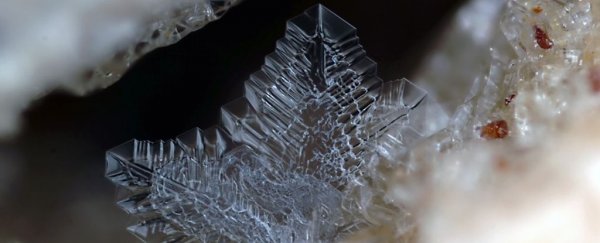In 2016, the Curiosity rover came across something really peculiar in Gale Crater on Mars.
On the slope of Mount Sharp, where Curiosity labored, were large quantities of a rare mineral; rare, at least, here on Earth. Tridymite, a form of quartz, only seems to form extremely seldom, and under high temperatures, such as those you might find in magma.
Although Mars shows extensive evidence of past basaltic volcanic activity in some regions, the once putatively water-filled Gale Crater is not one of those regions, leading scientists to puzzle about how the mineral came to be there.
Now a team led by planetary scientist Valerie Payré of the University of Arizona have figured out the mystery: that tridymite could have come from a single, explosive volcanic eruption, around 3.0 to 3.7 billion years ago.
"The discovery of tridymite in a mudstone in Gale Crater is one of the most surprising observations that the Curiosity rover has made in 10 years of exploring Mars," said Mars geologist Kirsten Siebach of Rice University.
"Tridymite is usually associated with quartz-forming, explosive, evolved volcanic systems on Earth, but we found it in the bottom of an ancient lake on Mars, where most of the volcanoes are very primitive."
Because we can't actually get to Mars, the scientists had two tools for figuring out the mystery: tridymite deposits found here on Earth, and the mineral samples collected from Gale Crater and Mount Sharp – the peak at the crater's center – by Curiosity, which sends data on its finds back to Earth.
So that's where Payré, then at Rice University, and her colleagues turned.
First, Earth. Every documented tridymite deposit and the conditions under which it formed were carefully examined by the research team.
Then, they sifted through the data collected by Curiosity on the composition of the long-ago dried-up sedimentary lakebed in the Gale Crater.
Tridymite forms at temperatures above 870 degrees Celsius (1,600 degrees Fahrenheit) and transforms into a phase called cristobalite at around 1,470 degrees Celsius. Both these forms were detected in a single layer on the slope of Mount Sharp.
In addition, Curiosity found feldspar and opaline silica, which on Earth can be found in volcanic contexts.
Putting these pieces together leads to a fascinating scenario involving a magmatic chamber beneath the Gale Crater billions of years ago. This chamber, the team surmised, would have sat under the lake for some time, more than is usual.
During this time, cooling would result in a process called fractional crystallization, removing and segregating minerals to produce an excess of silica.
When the chamber eventually erupted, it did so in a huge explosion that spewed ash containing the silica – now in the form of tridymite – into the air to rain back down into the lake in the Gale Crater and its surrounding tributaries.
These waters would have weathered and sorted the ash to produce the chemical composition of the layer as observed by Curiosity, the team said.
"It's actually a straightforward evolution of other volcanic rocks we found in the crater," Siebach explained.
"We argue that because we only saw this mineral once, and it was highly concentrated in a single layer, the volcano probably erupted at the same time the lake was there. Although the specific sample we analyzed was not exclusively volcanic ash, it was ash that had been weathered and sorted by water."
Because this silicic eruption is an evolved type that would have been different from the basaltic volcanism for which evidence abounds on Mars, the team's analysis suggests that the red planet may have had a much more complex volcanic history than we know.
Future missions, the team said, should look for evidence of other instances of this evolved volcanism to help constrain when and in what contexts it occurred on Mars.
"Mars," they wrote in their paper, "is not only a basaltic world."
The research has been published in Earth and Planetary Science Letters.
